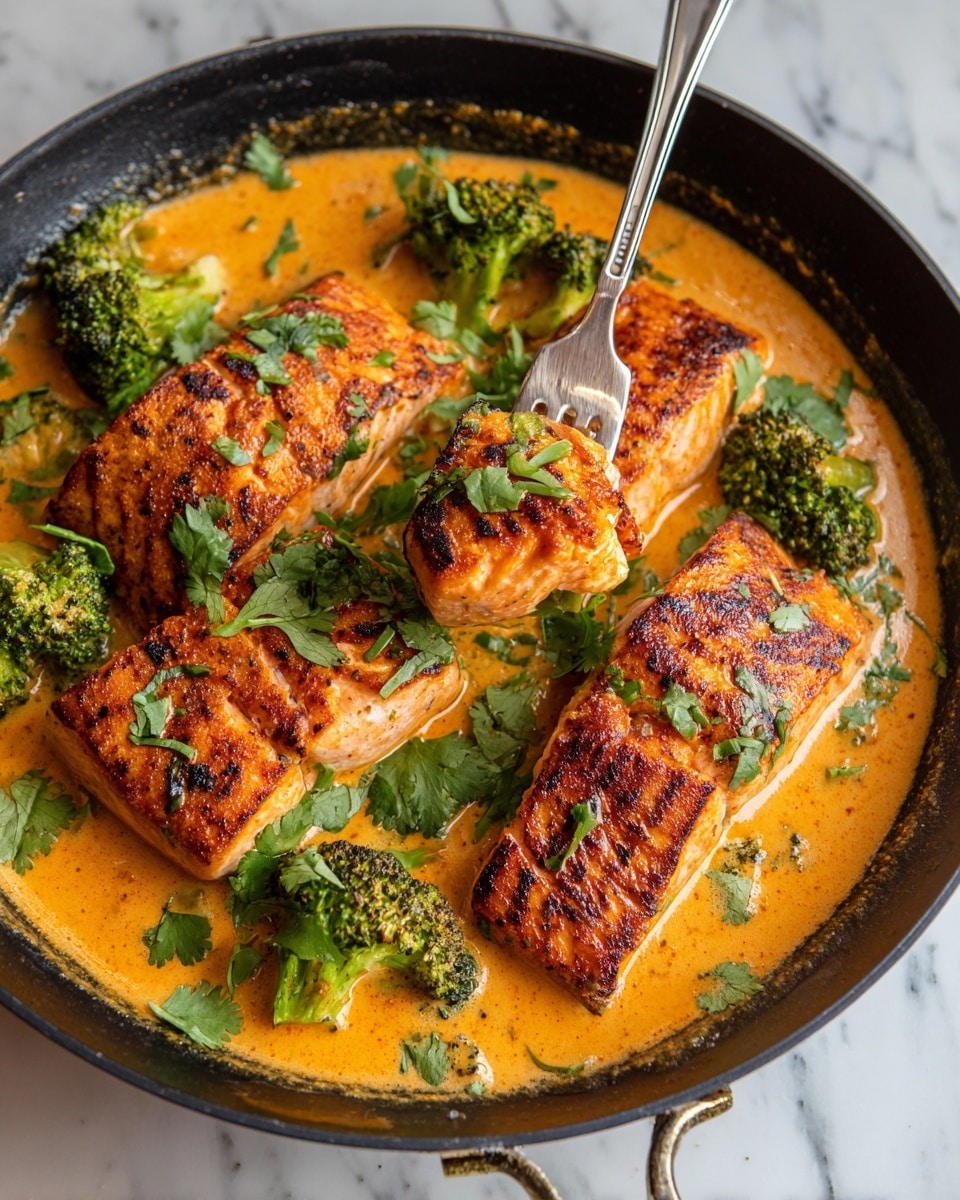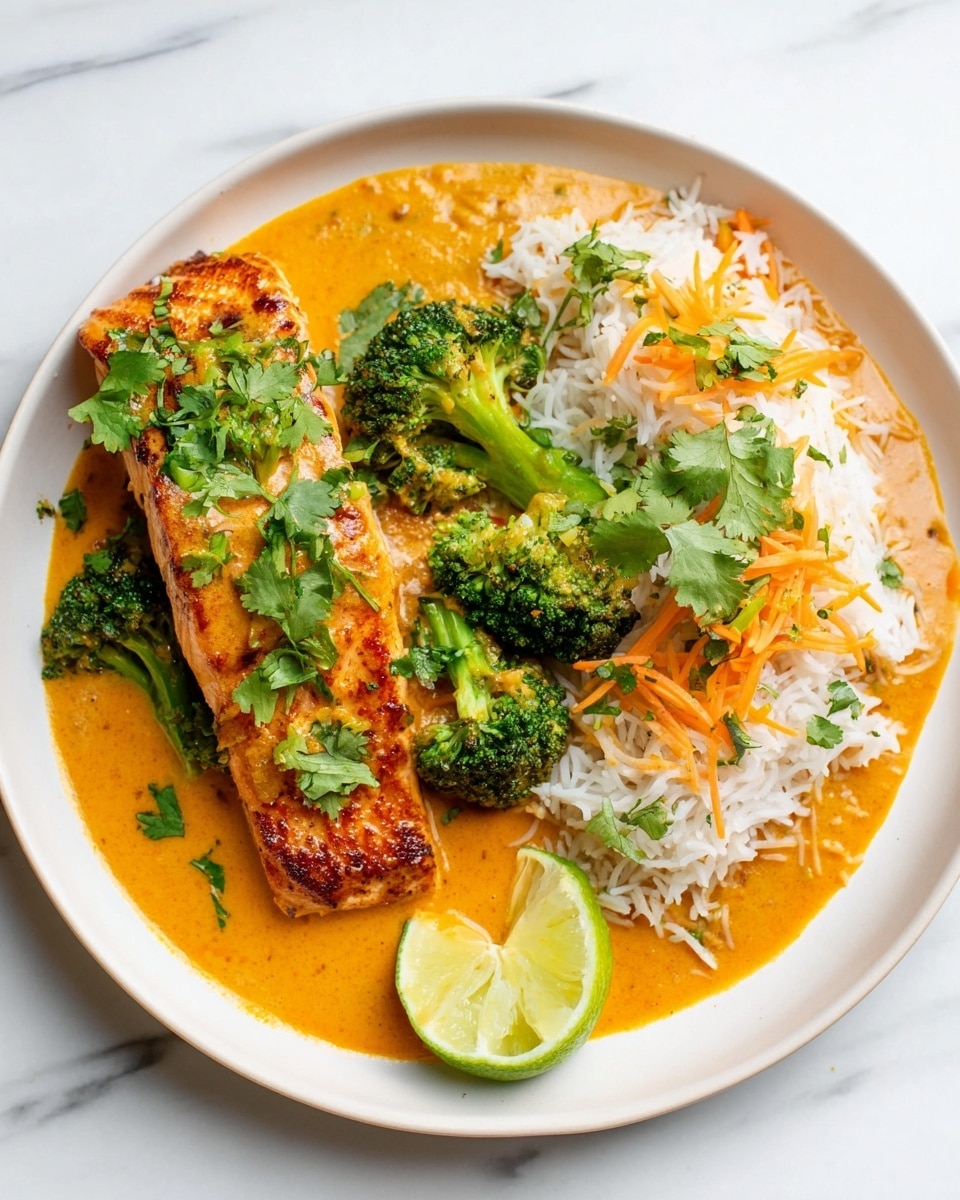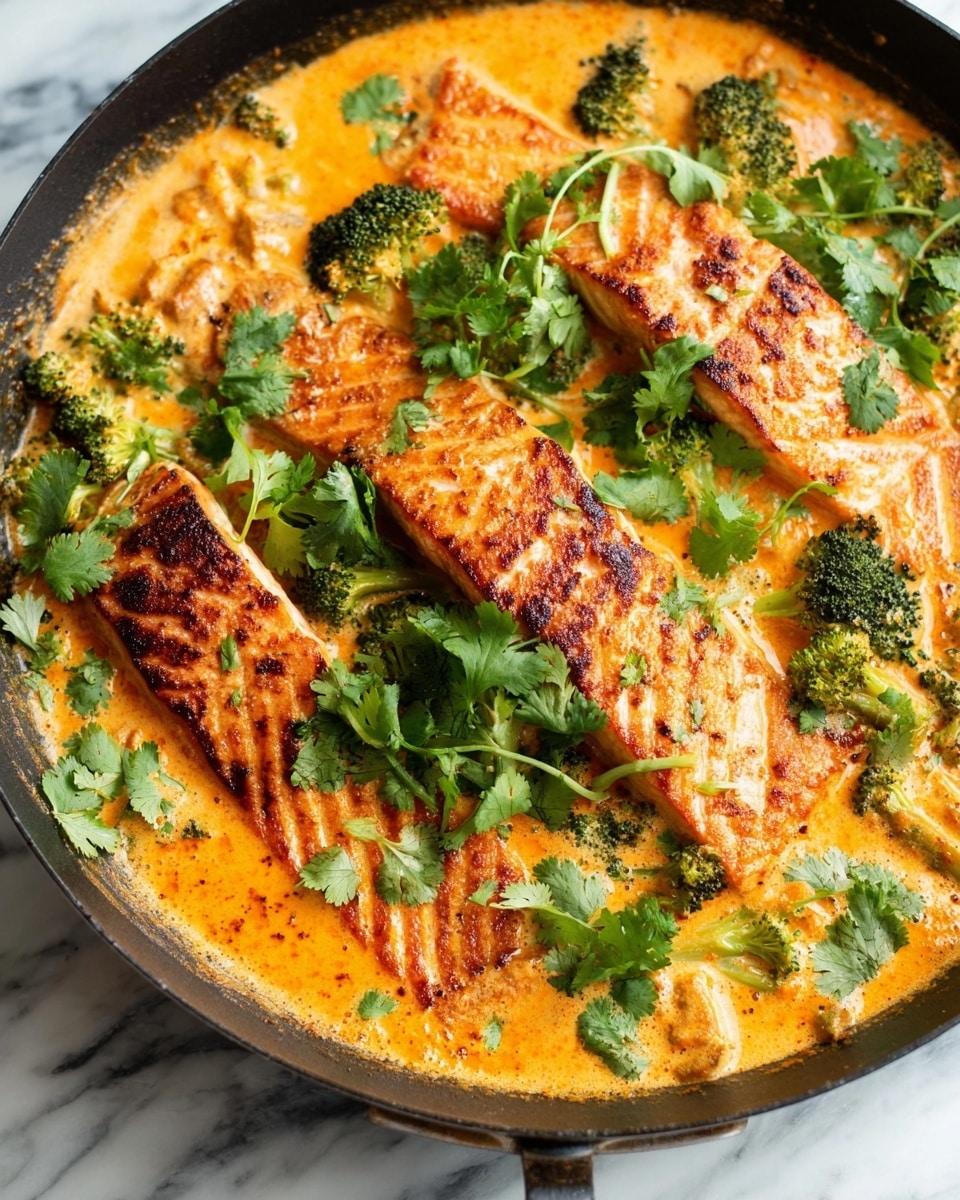If you’re looking for a cozy, flavor-packed dinner that’s both comforting and a little exotic, this Salmon Coconut Curry Recipe is going to become your new favorite. It’s one of those dishes I absolutely love because it’s quick to throw together yet full of rich, vibrant flavors that feel like a mini escape to tropical shores. Trust me, once you try this curry, you’ll find yourself craving it on repeat—and I can’t wait to share all my tips to help you nail it perfectly.
Why You’ll Love This Recipe
- Quick & Easy: Ready in just about 35 minutes, perfect for busy weeknights or last-minute guests.
- Flavor Explosion: The blend of creamy coconut milk, spicy Thai curry, and fresh herbs never disappoints.
- Healthy & Balanced: Loaded with omega-rich salmon and crisp veggies for a satisfying meal.
- Flexible Ingredients: Easy to customize depending on what you have in the fridge or pantry.
Ingredients You’ll Need
Each ingredient in this Salmon Coconut Curry Recipe plays a key role—from the richness of the coconut milk to the fresh brightness of the herbs. When shopping, I like to pick the freshest salmon I can find and some vibrant broccolini or a similar green vegetable to keep it colorful and nutritious.
- Fresh salmon: I recommend skin-on for extra flavor and crispiness when searing, but you can always take the skin off if you prefer.
- Salt & pepper: Simple seasonings that highlight the natural flavor of the salmon.
- Olive oil and butter: The combo gives the salmon a beautiful sear with rich depth—don’t skip the butter, it’s a game-changer here.
- Onion: Adds sweetness and a savory base to the curry sauce.
- Garlic: Brings aromatic warmth up a notch.
- Thai red curry paste: This is the heart of the curry—grab a good-quality paste with a balance of heat and flavor.
- Fish sauce (optional): Such a clever ingredient to add umami depth—I always use a splash, but feel free to skip if you prefer.
- Full-fat coconut milk: Creamy and rich, it softens the spice and makes the curry luxuriously smooth.
- Brown sugar: Just a touch to balance the savory and spicy notes.
- Carrots (matchstick cut): They add a bit of sweetness and crunch—you can swap in other crunchy veggies if you like.
- Broccolini: Tender yet crisp greens that soak up the curry beautifully—if you can’t find broccolini, baby broccoli or even asparagus work well.
- Lime juice: I always add fresh lime juice last for that zesty brightness that lifts all the flavors.
- Fresh basil and cilantro: These herbs finish the dish with fresh, fragrant notes—you’ll want these on hand!
Variations
I love how adaptable this Salmon Coconut Curry Recipe is. Over time, I’ve tweaked it depending on what veggies are seasonal or what I’m craving, so feel free to experiment and make it your own!
- Spicy kick: I sometimes add fresh sliced chilies or extra red curry paste if I’m in the mood for more heat—my family goes crazy for it when I do!
- Vegan version: Swap the salmon for tofu or chickpeas, and replace butter with coconut oil for a plant-based-friendly curry that’s just as tasty.
- Veggie swaps: Try green beans, snap peas, or bell peppers instead of or in addition to the broccolini and carrots—it keeps things fresh and seasonal.
- Milder version: If you’re serving this to kids or anyone sensitive to spice, reduce the curry paste amount and omit the fish sauce for a gentler flavor.
How to Make Salmon Coconut Curry Recipe
Step 1: Prep and Season Your Salmon
Start by cutting your fresh salmon into four equal pieces—this helps everything cook evenly. Pat each piece dry with a paper towel; trust me, this makes a huge difference in getting a nice sear. Season both sides generously with salt and pepper. This step is simple but essential to bring out the best flavor and texture in your fish.
Step 2: Sear the Salmon to Perfection
Heat a skillet over medium-high heat and add olive oil and butter. Give the pan a few minutes to get hot—this helps the salmon skin crisp up beautifully. Place the salmon skin-side down and don’t fuss with it; let it cook undisturbed for about 5 minutes. If it feels stuck, that’s actually a good sign—just wait a little longer for it to release naturally before flipping. Cook the other side for 2-3 minutes until almost done, then transfer the salmon to a plate. Pro tip: If you’re not a fan of salmon skin, it peels off easily once it’s cooked.
Step 3: Build the Flavor Base
Remove excess oil from the pan, leaving about a tablespoon behind. Toss in the chopped onion and sauté for around 3 minutes until it’s just starting to brown—this sweetness is the foundation. Add minced garlic and Thai red curry paste and cook for another minute until fragrant. The aroma that fills your kitchen here is one of my favorite parts of the whole process.
Step 4: Simmer the Coconut Curry Sauce
Pour in the fish sauce (if using), coconut milk, brown sugar, carrots, and broccolini. Let everything bubble gently for about 5 minutes. You want the vegetables tender-crisp—not mushy—so keep an eye on them and adjust cooking time to your preference. Stir occasionally to prevent sticking and help the flavors meld.
Step 5: Finish and Serve
Stir in fresh lime juice, then nestle the salmon pieces back into the curry sauce. Let the salmon warm through gently for 2-3 minutes. Taste and adjust salt and pepper as needed. Sprinkle torn basil and chopped cilantro over the top just before serving for a fresh herbal burst. And that’s it—your Salmon Coconut Curry Recipe is ready to enjoy!
Pro Tips for Making Salmon Coconut Curry Recipe
- Don’t Rush the Sear: Let the salmon develop a crust before flipping—it sticks at first but releases perfectly with a little patience.
- Use Full-Fat Coconut Milk: I discovered this trick the hard way—lower-fat versions lack the creamy texture this curry deserves.
- Add Veggies Last: Keeping carrots and broccolini crisp brings a lovely texture contrast to the creamy sauce.
- Adjust Seasoning at the End: Always taste before serving and add extra salt, lime, or herbs to brighten the final dish.
How to Serve Salmon Coconut Curry Recipe

Garnishes
For garnish, I like to sprinkle fresh chopped cilantro and basil leaves—it adds vibrant color and fresh, fragrant flavor that balances the creamy curry beautifully. A few lime wedges on the side are also perfect for guests who want an extra pop of citrus.
Side Dishes
This curry pairs wonderfully with steamed jasmine rice or even fragrant basmati—the rice soaks up all that delicious sauce. For a lower-carb option, cauliflower rice is great, too. Sometimes, I serve it with a simple cucumber salad to add crunch and cooling contrast.
Creative Ways to Present
For special occasions, I like to serve the curry directly in pretty coconut bowls or small terracotta pots for a fun tropical vibe. Garnishing with edible flowers—like nasturtiums or pansies—gives it a beautiful, festive touch that guests always comment on.
Make Ahead and Storage
Storing Leftovers
I usually store leftovers in an airtight container in the fridge, where they keep well for up to 3 days. The flavors actually deepen overnight, so if anything, it tastes even better the next day.
Freezing
Freezing is possible but I recommend removing the salmon pieces before freezing the curry sauce separately. Cooked salmon’s texture can change when frozen, so it’s best to add freshly cooked salmon to thawed curry when reheating for best results.
Reheating
Reheat gently over low heat on the stovetop, stirring occasionally. If the curry is too thick, add a splash of water or coconut milk to loosen it up. Avoid microwaving if possible—it can make the salmon tough.
FAQs
-
Can I use frozen salmon for this Salmon Coconut Curry Recipe?
Yes, you can! Just thaw the salmon completely and pat it dry before cooking. Frozen salmon tends to release more moisture, so drying it well helps you get a nice sear and prevents the curry from getting watery.
-
Is fish sauce necessary?
While not strictly necessary, fish sauce adds an authentic savory umami layer that really elevates this curry. If you’re not a fan or avoid seafood products, it’s perfectly fine to skip it or replace with soy sauce for a different twist.
-
How spicy is this curry?
The heat depends on your Thai red curry paste brand and how much you add. I use the recommended amount, which offers a pleasant medium heat that most people enjoy. You can adjust it down or up easily to suit your heat tolerance.
-
Can I substitute the broccolini?
Absolutely! Broccolini adds great texture, but green beans, asparagus, or even baby spinach can be excellent substitutions depending on what you have on hand.
Final Thoughts
This Salmon Coconut Curry Recipe has become one of my go-to meals for busy nights because it’s so satisfying and packed with flavor without a lot of fuss. I love how the creamy sauce pairs with flaky salmon and crisp veggies—and the fresh herbs at the end just bring it all to life. Give it a try, and I promise it’ll be one of those dishes you want to keep making for yourself, family, or friends. Cooking this feels like a little celebration each time, and I hope you feel the same joy when making and sharing it.
Print
Salmon Coconut Curry Recipe
- Prep Time: 15 minutes
- Cook Time: 20 minutes
- Total Time: 35 minutes
- Yield: 4 servings 1x
- Category: Main Dish
- Method: Stovetop
- Cuisine: Thai
- Diet: Halal
Description
A vibrant and creamy Salmon Coconut Curry featuring tender salmon pieces simmered in a rich Thai red curry and coconut milk sauce, accented with fresh herbs and crisp vegetables for a delightful and comforting meal.
Ingredients
Salmon
- 1 pound fresh salmon
- Salt & pepper to taste
- 1 tablespoon olive oil
- 1 tablespoon butter
Curry Sauce and Vegetables
- 1/2 medium onion, chopped
- 2 cloves garlic, minced
- 2 heaping tablespoons Thai red curry paste
- 1/2 teaspoon fish sauce (optional but recommended)
- 1 (13.5 ounce) can full-fat coconut milk
- 1/2 teaspoon brown sugar
- 1/2 cup matchstick cut carrots
- 1 heaping cup chopped broccolini
- 1 teaspoon lime juice
- 2 tablespoons torn/chopped fresh basil
- 2 tablespoons chopped fresh cilantro
Instructions
- Prepare the Salmon: Cut the salmon into 4 equal pieces. Pat both sides dry with a paper towel and season with salt and pepper to taste, ensuring the fish is evenly seasoned for optimal flavor.
- Heat the Pan: Add the olive oil and butter to a skillet over medium-high heat. Allow the pan to heat thoroughly for a few minutes until the butter is melted and the oil is hot but not smoking.
- Cook the Salmon: Place the salmon pieces skin-side down in the skillet. Cook for 5 minutes without moving to develop a crispy skin and prevent sticking. Flip and cook for an additional 2-3 minutes until the salmon is nearly cooked through. If the fish sticks, give it more time to release naturally rather than forcing it.
- Remove the Salmon: Transfer the salmon to a plate. If you prefer, you can slide off the skin before returning the salmon to the pan later, making for easier serving.
- Prepare the Curry Base: Spoon out some of the oil from the skillet, leaving about a tablespoon behind. Add the chopped onion to the skillet and sauté for about 3 minutes until it starts to brown lightly.
- Add Aromatics and Curry Paste: Stir in the minced garlic and Thai red curry paste, cooking for an additional 1 minute to release their fragrances and flavors.
- Simmer the Sauce and Vegetables: Pour in the fish sauce (if using), full-fat coconut milk, and add the brown sugar. Stir to combine, then add the carrots and broccolini. Let the mixture gently bubble over medium heat for about 5 minutes, allowing the vegetables to become tender-crisp. Cook longer if you prefer softer vegetables.
- Finish the Curry: Stir in the lime juice, then gently nestle the salmon pieces back into the pan. Allow the fish to warm through for a couple of minutes, seasoning with additional salt and pepper as needed.
- Garnish and Serve: Sprinkle freshly chopped basil and cilantro over the curry. Serve immediately for the best flavor and texture experience.
Notes
- Fish sauce adds umami depth, but it can be omitted for those sensitive to its strong flavor, or substituted with soy sauce for a different twist.
- If you prefer not to eat the salmon skin, it can be easily removed after cooking.
- Adjust the cooking time of vegetables depending on your preferred level of tenderness.
- Serve with steamed jasmine rice or noodles to complement the curry sauce.
- Leftovers can be stored in the refrigerator for up to 2 days; reheat gently to avoid overcooking the salmon.
Nutrition
- Serving Size: 1 serving (1/4 recipe)
- Calories: 400
- Sugar: 4 g
- Sodium: 550 mg
- Fat: 28 g
- Saturated Fat: 18 g
- Unsaturated Fat: 9 g
- Trans Fat: 0 g
- Carbohydrates: 9 g
- Fiber: 2 g
- Protein: 30 g
- Cholesterol: 70 mg




Your email address will not be published. Required fields are marked *